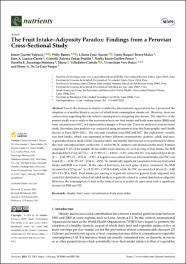| dc.contributor.author | Guerra Valencia, Jamee | |
| dc.contributor.author | Ramos, Willy | |
| dc.contributor.author | Cruz-Ausejo, Liliana | |
| dc.contributor.author | Torres-Malca, Jenny Raquel | |
| dc.contributor.author | Loayza-Castro, Joan A. | |
| dc.contributor.author | Zeñas-Trujillo, Gianella Zulema | |
| dc.contributor.author | Guillen Ponce, Norka Rocío | |
| dc.contributor.author | Zuzunaga-Montoya, Fiorella E. | |
| dc.contributor.author | Valladares-Garrido, Mario J. | |
| dc.contributor.author | Vera-Ponce, Víctor Juan | |
| dc.contributor.author | De La Cruz-Vargas, Jhony A. | |
| dc.date.accessioned | 2023-05-22T15:57:28Z | |
| dc.date.available | 2023-05-22T15:57:28Z | |
| dc.date.issued | 2023-02-27 | |
| dc.identifier.uri | https://hdl.handle.net/20.500.13053/8607 | |
| dc.description.abstract | “Due to the increase in obesity worldwide, international organizations have promoted the
adoption of a healthy lifestyle, as part of which fruit consumption stands out. However, there are
controversies regarding the role of fruit consumption in mitigating this disease. The objective of the
present study was to analyze the association between fruit intake and body mass index (BMI) and
waist circumference (WC) in a representative sample of Peruvians. This is an analytical cross-sectional
study. Secondary data analysis was conducted using information from the Demographic and Health
Survey of Peru (2019–2021). The outcome variables were BMI and WC. The exploratory variable
was fruit intake, which was expressed in three different presentations: portion, salad, and juice.
A generalized linear model of the Gaussian family and identity link function were performed to obtain
the crude and adjusted beta coefficients. A total of 98,741 subjects were included in the study. Females
comprised 54.4% of the sample. In the multivariate analysis, for each serving of fruit intake, the BMI
decreased by 0.15 kg/m2
(β = −0.15; 95% CI −0.24 to −0.07), while the WC was reduced by 0.40 cm
(β = −0.40; 95% CI −0.52 to −0.27). A negative association between fruit salad intake and WC was
found (β = −0.28; 95% CI −0.56 to −0.01). No statistically significant association between fruit salad
intake and BMI was found. In the case of fruit juice, for each glass of juice consumed, the BMI
increased by 0.27 kg/m2
(β = 0.27; 95% CI 0.14 to 0.40), while the WC increased by 0.40 cm (β = 0.40;
95% CI 0.20 to 0.60). Fruit intake per serving is negatively related to general body adiposity and
central fat distribution, while fruit salad intake is negatively related to central distribution adiposity.
However, the consumption of fruit in the form of juices is positively associated with a significant
increase in BMI and WC.
“ | es_PE |
| dc.format | application/pdf | es_PE |
| dc.language.iso | eng | es_PE |
| dc.publisher | MDPI | es_PE |
| dc.rights | info:eu-repo/semantics/openAccess | es_PE |
| dc.rights.uri | https://creativecommons.org/licenses/by/4.0/ | es_PE |
| dc.subject | obesity; fruit; waist circumference; body mass index | es_PE |
| dc.title | The Fruit Intake–Adiposity Paradox: Findings from a Peruvian Cross-Sectional Study | es_PE |
| dc.type | info:eu-repo/semantics/article | es_PE |
| dc.identifier.doi | "https://doi.org/10.3390/ nu15051183" | |
| dc.type.version | info:eu-repo/semantics/publishedVersion | es_PE |
| dc.publisher.country | CH | es_PE |
| dc.subject.ocde | 3.00.00 -- Ciencias médicas, Ciencias de la salud | es_PE |


